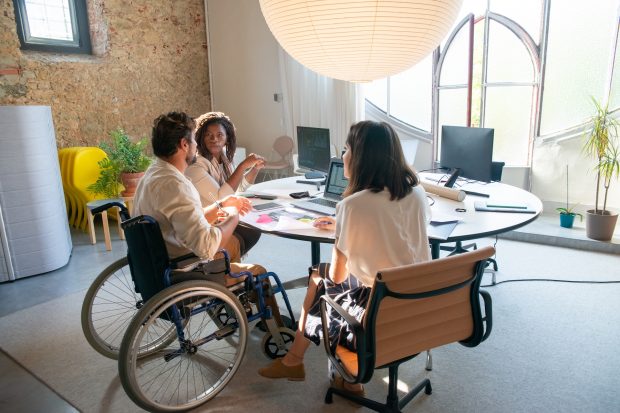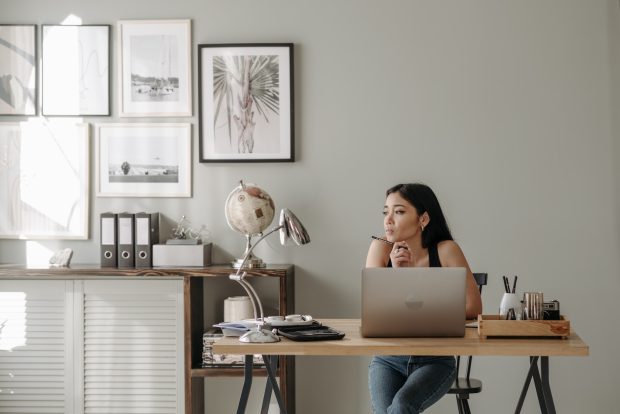Creating a well-designed office space is crucial to the success of any business. The design of an office can have a significant impact on employee productivity, creativity, and overall well-being. When planning an office design, there are many factors to consider, including space requirements, layout and flow, lighting, color scheme, furniture, and technology. Each of these factors plays a crucial role in creating a functional and comfortable workspace that meets the needs of both employees and the business as a whole. In this article, we’ll dive deeper into each of these factors and explore the benefits of buying second-hand office furniture as a cost-effective and sustainable option.

Space Requirements
Space requirements refer to the amount of physical space required to accommodate the needs of the business and its employees. When planning an office design, it’s essential to consider the size of the office, the number of employees who will be working in the space, and the type of work that will be done. The space requirements may vary depending on the nature of the business. For example, a tech company may require more open space for collaboration, while a law firm may require more private offices for client meetings. It’s important to ensure that the office space is not too cramped, as this can lead to discomfort and reduced productivity among employees. On the other hand, a space that is too large can be inefficient and may result in unnecessary expenses. Careful consideration of space requirements can help businesses create a workspace that maximizes productivity, efficiency, and employee satisfaction.
Buying Second-Hand Office Furniture
One way to save money when planning an office design is to buy used office furniture. There are many benefits to buying second-hand office furniture, including cost savings, reduced environmental impact, and the ability to find unique and vintage pieces. However, there are also some potential drawbacks to consider. Used furniture may be less durable or have wear and tear, and you’ll need to ensure that it meets safety and ergonomic standards. Additionally, you’ll need to factor in the cost of transporting and assembling the furniture, as well as any necessary repairs or cleaning. Despite these potential challenges, buying second-hand office furniture can be a smart and sustainable choice for many businesses. However, it’s important to ensure that the furniture is still functional, comfortable, and fits with the overall design aesthetic of the office.
Layout and Flow
This is the arrangement of furniture, equipment, and other elements within an office space, and how people move through that space. A well-designed office layout should allow for easy and efficient movement of people and resources. The goal is to create a space that maximizes productivity and minimizes distractions, with a clear path for employees to move from one area to another without obstacles. The layout and flow of an office space should be tailored to the needs of the business and the work being done. For example, an open layout with collaborative workstations may be suitable for a creative agency, while a more traditional layout with private offices may be more appropriate for a law firm. The layout should also allow for adequate storage space, meeting areas, and other essential features.
Lighting
When choosing lighting for an office, consider the amount of natural light available and supplement with artificial lighting if necessary. Choose lighting appropriate for the task being performed, such as task lighting for detailed work. Consider the color temperature of the lighting, with cooler temperatures promoting productivity and warmer temperatures promoting relaxation. Use a mix of lighting types, such as overhead lighting and floor lamps, to create a well-lit and dynamic space. Ensure that lighting is evenly distributed throughout the space to reduce glare and eye strain. Consider implementing lighting controls, such as dimmer switches or motion sensors, to save energy and provide flexibility. Finally, keep in mind the style and design of the lighting fixtures to ensure they fit the overall aesthetic of the office.
Color Scheme
Choosing the right color scheme is crucial when designing an office space. You should consider the company’s branding and values when selecting colors. Cool colors like blue and green can promote focus and productivity, while warm colors like red and orange can promote energy and creativity. Also, consider the psychological impact of colors on employees and choose colors that align with the intended mood of the space. Use neutrals like white or beige to balance out bolder colors and create a cohesive look. In addition, test colors in the space before making a final decision to ensure they look good in the lighting and with the other elements of the office design. You should bear in mind the impact of natural light on the colors in the space, as it can affect the way colors are perceived.
Technology
Technology has become an integral part of the modern office environment, and it’s important to ensure that it is seamlessly integrated into the overall office design. When incorporating technology into an office space, it’s important to consider the placement of technology, ensuring that it is easily accessible and functional for employees. This may include providing outlets and charging stations throughout the office or incorporating technology into collaborative workspaces. Additionally, it’s important to consider the aesthetics of the technology, ensuring that it fits with the overall design aesthetic of the office. This can be achieved through the use of sleek, modern devices or by concealing technology behind furniture or other elements in the space.
In conclusion, designing an office space that is functional, comfortable, and visually appealing requires careful consideration of several key factors. Space requirements, layout and flow, lighting, color scheme, furniture, technology, and sustainability are all important considerations that can impact the success of the office design. By taking into account the specific needs of the business and its employees, as well as current trends in office design, businesses can create a space that fosters productivity, collaboration, and employee satisfaction. Investing in the right office design can also improve the perception of the business among clients, partners, and employees, ultimately leading to increased success and growth.




